tow GENESIS G70 2021 Owner's Guide
[x] Cancel search | Manufacturer: GENESIS, Model Year: 2021, Model line: G70, Model: GENESIS G70 2021Pages: 516, PDF Size: 12.84 MB
Page 251 of 516
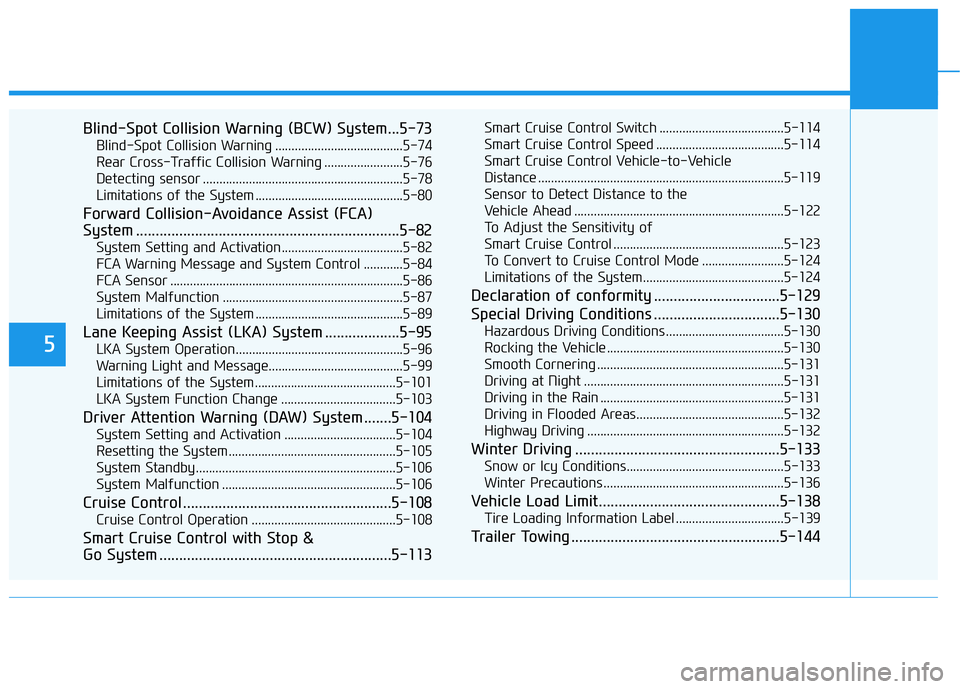
5
Blind-Spot Collision Warning (BCW) System...5-73
Blind-Spot Collision Warning .......................................5-74
Rear Cross-Traffic Collision Warning ........................5-76
Detecting sensor .............................................................5-78
Limitations of the System .............................................5-80
Forward Collision-Avoidance Assist (FCA)
System ...................................................................5-82
System Setting and Activation.....................................5-82
FCA Warning Message and System Control ............5-84
FCA Sensor .......................................................................5-86
System Malfunction .......................................................5-87
Limitations of the System .............................................5-89
Lane Keeping Assist (LKA) System ...................5-95
LKA System Operation...................................................5-96
Warning Light and Message.........................................5-99
Limitations of the System...........................................5-101
LKA System Function Change ...................................5-103
Driver Attention Warning (DAW) System .......5-104
System Setting and Activation ..................................5-104
Resetting the System ...................................................5-105
System Standby.............................................................5-106
System Malfunction .....................................................5-106
Cruise Control .....................................................5-108
Cruise Control Operation ............................................5-108
Smart Cruise Control with Stop &
Go System ...........................................................5-113
Smart Cruise Control Switch ......................................5-114
Smart Cruise Control Speed .......................................5-114
Smart Cruise Control Vehicle-to-Vehicle
Distance ...........................................................................5-119
Sensor to Detect Distance to the
Vehicle Ahead ................................................................5-122
To Adjust the Sensitivity of
Smart Cruise Control ....................................................5-123
To Convert to Cruise Control Mode .........................5-124
Limitations of the System...........................................5-124
Declaration of conformity ................................5-129
Special Driving Conditions ................................5-130
Hazardous Driving Conditions....................................5-130
Rocking the Vehicle ......................................................5-130
Smooth Cornering .........................................................5-131
Driving at Night .............................................................5-131
Driving in the Rain ........................................................5-131
Driving in Flooded Areas.............................................5-132
Highway Driving ............................................................5-132
Winter Driving ....................................................5-133
Snow or Icy Conditions................................................5-133
Winter Precautions .......................................................5-136
Vehicle Load Limit..............................................5-138
Tire Loading Information Label .................................5-139
Trailer Towing .....................................................5-144
Page 259 of 516

5-10
Vehicle with automatic transmission :
1. Always carry the smart key with
you.
2. Make sure the parking brake is
applied.
3. Make sure the vehicle is shifted to
P (Park).
4. Depress the brake pedal.
5. Press the Engine Start/Stop but-
ton.
Information
• Do not wait for the engine to warm
up while the vehicle remains station-
ary. Start driving at moderate
engine speeds. (Aggressive accelerat-
ing and decelerating should be
avoided.)
• Always start the vehicle with your
foot on the brake pedal. Do not
depress the accelerator while start-
ing the vehicle. Do not rev the
engine while warming it up.To prevent damage to the vehicle:
• If the engine stalls while you are
in motion, do not attempt to shift
to the P (Park) position.
If traffic and road conditions
permit, you may put the shift
lever in the N (Neutral) position
while the vehicle is still moving
and press the Engine Start/Stop
button in an attempt to restart
the engine.
• Do not push or tow your vehicle
to start the engine.To prevent damage to the vehicle:
When the stop lamp switch fuse is
blown, you can't start the engine
normally. Replace the fuse with a
new one. If you are not able to
replace the fuse, you can start the
engine by pressing and holding
the Engine Start/Stop button for
10 seconds with the Engine Start/
Stop button in the ACC position.
Do not press the Engine Start/Stop
button for more than 10 seconds
except when the stop lamp switch
fuse is blown.
For your safety always depress
the brake and/or clutch pedal
before starting the engine.
NOTICENOTICE
i
Driving your vehicle
Page 271 of 516

5-22
Driving your vehicle
To change back to the automatic shift
mode from manual shift mode, do
one of the following:
• Move the shift lever down toward
the D (Drive) position.
• Gently depress the accelerator
pedal for more than 5 seconds.
• Drive the vehicle under 4 mph (7
km/h).
• Pull and hold the right side paddle
shifter.
Information
If the [+] and [-] paddle shifters are
pulled at the same time, gear change
may not occur.
LCD Display Messages
Shifter system malfunction
The message appears on the LCD
display when the transmission or the
shift lever does not properly operate
in the P (Park) position.
Immediately have the vehicle
inspected by an authorized retailer of
Genesis Branded products.
Check shift lever
The message appears on the LCD
display when there is a malfunction
with one of the key transmission
shifter components.
Immediately have the vehicle
inspected by an authorized retailer of
Genesis Branded products.iOIK057042N
OIK057043L
Page 286 of 516

5-37
Driving your vehicle
5
The EPB malfunction indicator may
illuminate when the ESC indicator
comes on to indicate that the ESC is
not working properly, but it does not
indicate a malfunction of the EPB.
• If the EPB warning light is still
on, have the system checked by
an authorized retailer of Genesis
Branded products.
• If the parking brake warning
light does not illuminate or
blinks even though the EPB
switch was pulled up, the EPB
may not be applied.
• If the parking brake warning
light blinks when the EPB warn-
ing light is on, press the switch,
and then pull it up. Repeat this
one more time. If the EPB warn-
ing does not go off, have the
system checked by an author-
ized retailer of Genesis Branded
products.Emergency braking
If there is a problem with the brake
pedal while driving, emergency brak-
ing is possible by pulling up and
holding the EPB switch. Braking is
possible only while you are holding
the EPB switch. However, braking
distance will be longer than normal.
Information
During emergency braking, the park-
ing brake warning light will illumi-
nate to indicate that the system is
operating.If you continuously notice a noise
or burning smell when the EPB is
used for emergency braking, have
the system checked by an author-
ized retailer of Genesis Branded
products.
When the EPB (Electronic Parking
Brake) does not release
If the EPB does not release normal-
ly, contact an authorized retailer of
Genesis Branded products by load-
ing the vehicle on a flatbed tow truck
and have the system checked.
NOTICE
i
NOTICE
Do not operate the parking
brake while the vehicle is mov-
ing except in an emergency sit-
uation. It could damage the
brake system and lead to a
severe accident.
WARNING
Page 299 of 516

5-50
Driving your vehicle
Information
• Do not drive in water if the level is
higher than the bottom of the vehi-
cle.
• Check your brake condition once
you are out of mud or water.
Depress the brake pedal several
times as you move slowly until you
feel normal braking return.
• Shorten your scheduled mainte-
nance interval if you drive in off-
road conditions such as sand, mud
or water (see "Maintenance Under
Severe Usage Conditions" in chap-
ter 7).
• Make sure that an AWD vehicle is
towed by flatbed tow truck.
For safe AWD operation
Before driving
• Make sure all passengers are
wearing seat belts.
• Sit upright and adjust the steering
wheel to a position comfortable for
you to drive.
Driving on snow-covered or icy
roads
• Start off slowly by applying the
accelerator pedal gently.
• Use of snow tires is recommended.
For more information on Snow
Tires refer to "Winter Driving" in
this chapter.
• Keep sufficient distance between
your vehicle and the vehicle in front
of you.
• When approaching a stop sign or
stop light, release the accelerator
pedal to provide engine braking
during deceleration.
• Avoid speeding, rapid acceleration,
sudden brake applications, and
sharp turns to prevent skids.
Driving in sand or mud
• Maintain slow and constant speed.
• Keep sufficient distance between
your vehicle and the vehicle in front
of you.
• Reduce vehicle speed and always
check the road condition.
• Avoid speeding, rapid acceleration,
sudden brake applications, and
sharp turns to prevent getting
stuck.
When the vehicle is stuck in snow,
sand or mud, avoid running the
engine continuously at high rpm,
doing so may damage the tires,
transmission, differential or AWD
system.
NOTICE
i
Page 301 of 516
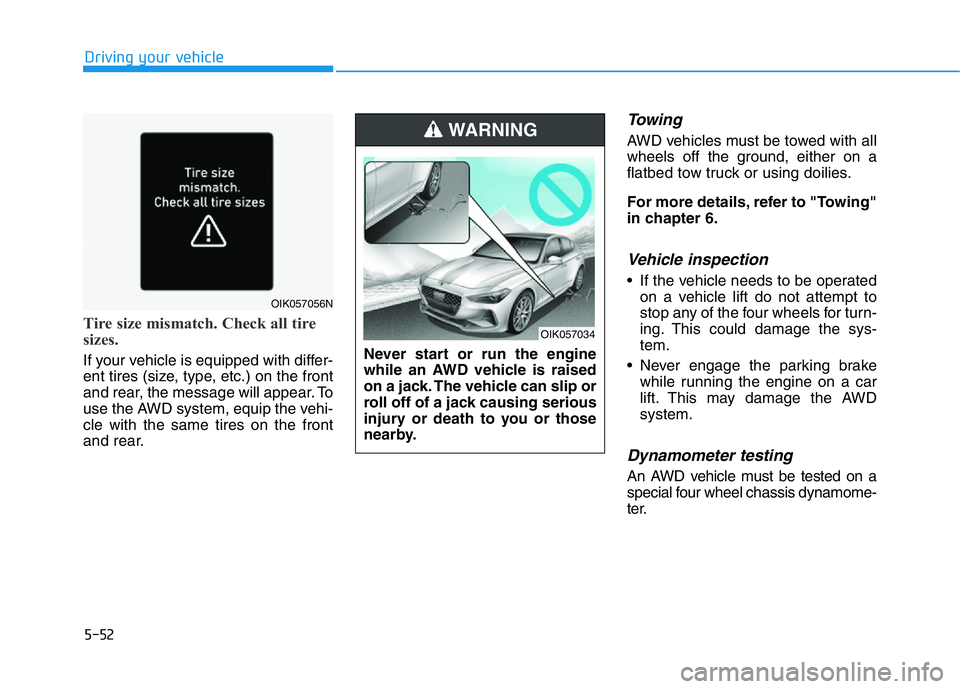
5-52
Driving your vehicle
Tire size mismatch. Check all tire
sizes.
If your vehicle is equipped with differ-
ent tires (size, type, etc.) on the front
and rear, the message will appear. To
use the AWD system, equip the vehi-
cle with the same tires on the front
and rear.
Towing
AWD vehicles must be towed with all
wheels off the ground, either on a
flatbed tow truck or using doilies.
For more details, refer to "Towing"
in chapter 6.
Vehicle inspection
• If the vehicle needs to be operated
on a vehicle lift do not attempt to
stop any of the four wheels for turn-
ing. This could damage the sys-
tem.
• Never engage the parking brake
while running the engine on a car
lift. This may damage the AWD
system.
Dynamometer testing
An AWD vehicle must be tested on a
special four wheel chassis dynamome-
ter. Never start or run the engine
while an AWD vehicle is raised
on a jack. The vehicle can slip or
roll off of a jack causing serious
injury or death to you or those
nearby.
WARNING
OIK057056N
OIK057034
Page 337 of 516
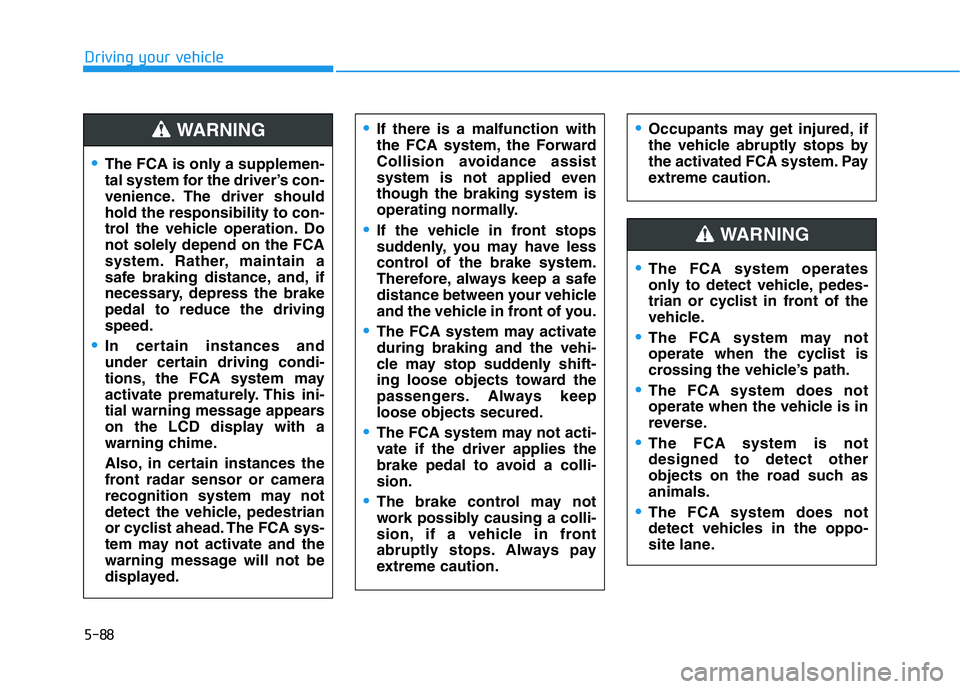
5-88
Driving your vehicle
•The FCA is only a supplemen-
tal system for the driver’s con-
venience. The driver should
hold the responsibility to con-
trol the vehicle operation. Do
not solely depend on the FCA
system. Rather, maintain a
safe braking distance, and, if
necessary, depress the brake
pedal to reduce the driving
speed.
•In certain instances and
under certain driving condi-
tions, the FCA system may
activate prematurely. This ini-
tial warning message appears
on the LCD display with a
warning chime.
Also, in certain instances the
front radar sensor or camera
recognition system may not
detect the vehicle, pedestrian
or cyclist ahead. The FCA sys-
tem may not activate and the
warning message will not be
displayed.
WARNING •If there is a malfunction with
the FCA system, the Forward
Collision avoidance assist
system is not applied even
though the braking system is
operating normally.
•If the vehicle in front stops
suddenly, you may have less
control of the brake system.
Therefore, always keep a safe
distance between your vehicle
and the vehicle in front of you.
•The FCA system may activate
during braking and the vehi-
cle may stop suddenly shift-
ing loose objects toward the
passengers. Always keep
loose objects secured.
•The FCA system may not acti-
vate if the driver applies the
brake pedal to avoid a colli-
sion.
•The brake control may not
work possibly causing a colli-
sion, if a vehicle in front
abruptly stops. Always pay
extreme caution.
•Occupants may get injured, if
the vehicle abruptly stops by
the activated FCA system. Pay
extreme caution.
•The FCA system operates
only to detect vehicle, pedes-
trian or cyclist in front of the
vehicle.
•The FCA system may not
operate when the cyclist is
crossing the vehicle’s path.
•The FCA system does not
operate when the vehicle is in
reverse.
•The FCA system is not
designed to detect other
objects on the road such as
animals.
•The FCA system does not
detect vehicles in the oppo-
site lane.
WARNING
Page 339 of 516
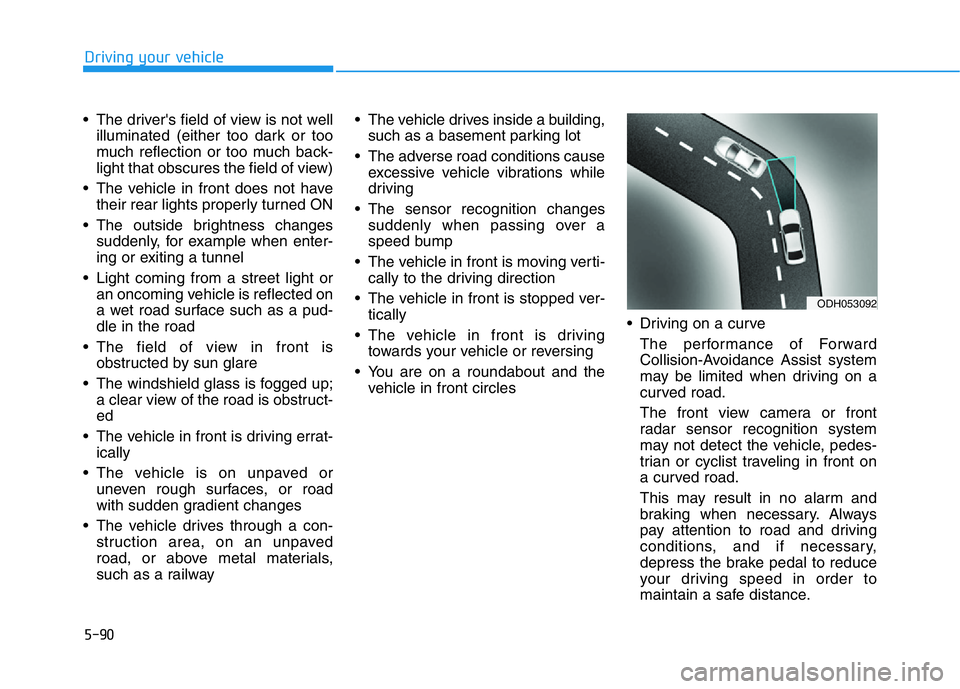
5-90
Driving your vehicle
• The driver's field of view is not well
illuminated (either too dark or too
much reflection or too much back-
light that obscures the field of view)
• The vehicle in front does not have
their rear lights properly turned ON
• The outside brightness changes
suddenly, for example when enter-
ing or exiting a tunnel
• Light coming from a street light or
an oncoming vehicle is reflected on
a wet road surface such as a pud-
dle in the road
• The field of view in front is
obstructed by sun glare
• The windshield glass is fogged up;
a clear view of the road is obstruct-
ed
• The vehicle in front is driving errat-
ically
• The vehicle is on unpaved or
uneven rough surfaces, or road
with sudden gradient changes
• The vehicle drives through a con-
struction area, on an unpaved
road, or above metal materials,
such as a railway• The vehicle drives inside a building,
such as a basement parking lot
• The adverse road conditions cause
excessive vehicle vibrations while
driving
• The sensor recognition changes
suddenly when passing over a
speed bump
• The vehicle in front is moving verti-
cally to the driving direction
• The vehicle in front is stopped ver-
tically
• The vehicle in front is driving
towards your vehicle or reversing
• You are on a roundabout and the
vehicle in front circles• Driving on a curve
The performance of Forward
Collision-Avoidance Assist system
may be limited when driving on a
curved road.
The front view camera or front
radar sensor recognition system
may not detect the vehicle, pedes-
trian or cyclist traveling in front on
a curved road.
This may result in no alarm and
braking when necessary. Always
pay attention to road and driving
conditions, and if necessary,
depress the brake pedal to reduce
your driving speed in order to
maintain a safe distance.
ODH053092
Page 343 of 516
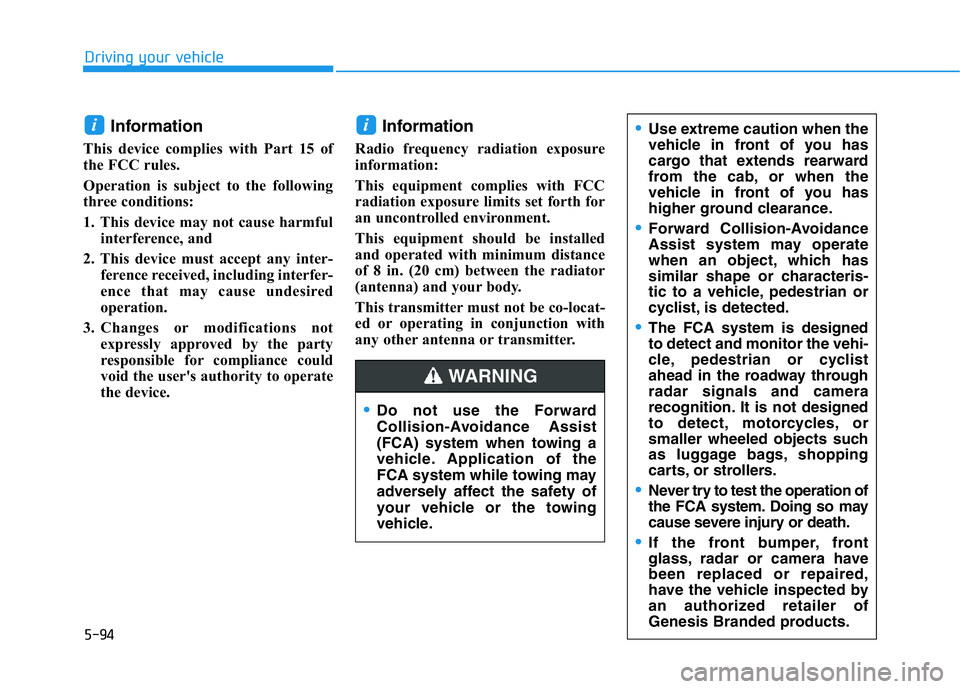
5-94
Driving your vehicle
Information
This device complies with Part 15 of
the FCC rules.
Operation is subject to the following
three conditions:
1. This device may not cause harmful
interference, and
2. This device must accept any inter-
ference received, including interfer-
ence that may cause undesired
operation.
3. Changes or modifications not
expressly approved by the party
responsible for compliance could
void the user's authority to operate
the device.
Information
Radio frequency radiation exposure
information:
This equipment complies with FCC
radiation exposure limits set forth for
an uncontrolled environment.
This equipment should be installed
and operated with minimum distance
of 8 in. (20 cm) between the radiator
(antenna) and your body.
This transmitter must not be co-locat-
ed or operating in conjunction with
any other antenna or transmitter.
ii
•Do not use the Forward
Collision-Avoidance Assist
(FCA) system when towing a
vehicle. Application of the
FCA system while towing may
adversely affect the safety of
your vehicle or the towing
vehicle.
•Use extreme caution when the
vehicle in front of you has
cargo that extends rearward
from the cab, or when the
vehicle in front of you has
higher ground clearance.
•Forward Collision-Avoidance
Assist system may operate
when an object, which has
similar shape or characteris-
tic to a vehicle, pedestrian or
cyclist, is detected.
•The FCA system is designed
to detect and monitor the vehi-
cle, pedestrian or cyclist
ahead in the roadway through
radar signals and camera
recognition. It is not designed
to detect, motorcycles, or
smaller wheeled objects such
as luggage bags, shopping
carts, or strollers.
•Never try to test the operation of
the FCA system. Doing so may
cause severe injury or death.
•If the front bumper, front
glass, radar or camera have
been replaced or repaired,
have the vehicle inspected by
an authorized retailer of
Genesis Branded products.
WARNING
Page 345 of 516
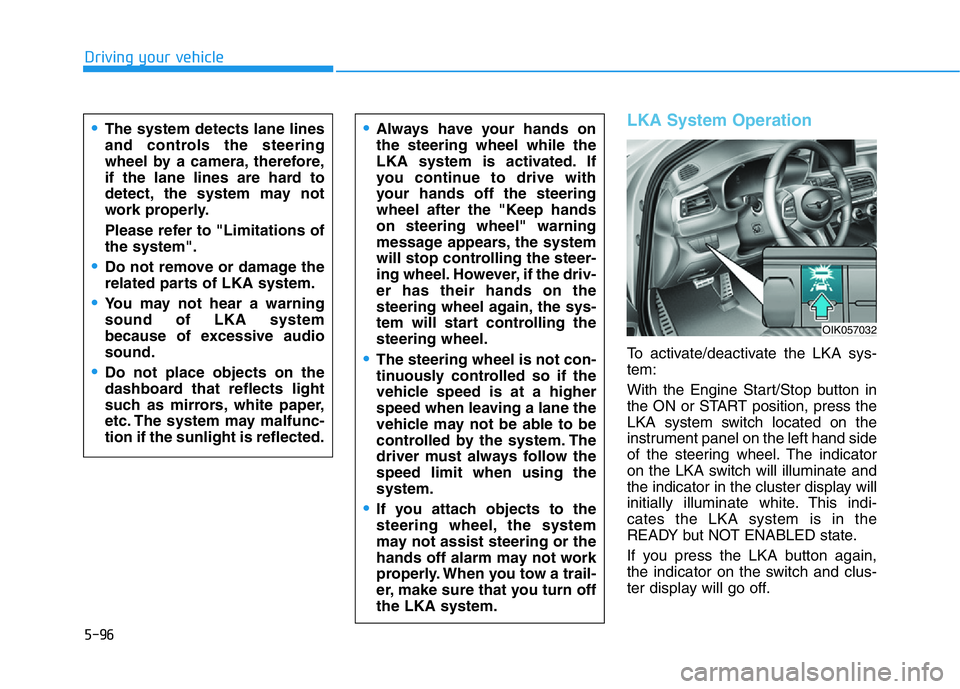
5-96
Driving your vehicle
LKA System Operation
To activate/deactivate the LKA sys-
tem:
With the Engine Start/Stop button in
the ON or START position, press the
LKA system switch located on the
instrument panel on the left hand side
of the steering wheel. The indicator
on the LKA switch will illuminate and
the indicator in the cluster display will
initially illuminate white. This indi-
cates the LKA system is in the
READY but NOT ENABLED state.
If you press the LKA button again,
the indicator on the switch and clus-
ter display will go off.
•Always have your hands on
the steering wheel while the
LKA system is activated. If
you continue to drive with
your hands off the steering
wheel after the "Keep hands
on steering wheel" warning
message appears, the system
will stop controlling the steer-
ing wheel. However, if the driv-
er has their hands on the
steering wheel again, the sys-
tem will start controlling the
steering wheel.
•The steering wheel is not con-
tinuously controlled so if the
vehicle speed is at a higher
speed when leaving a lane the
vehicle may not be able to be
controlled by the system. The
driver must always follow the
speed limit when using the
system.
•If you attach objects to the
steering wheel, the system
may not assist steering or the
hands off alarm may not work
properly. When you tow a trail-
er, make sure that you turn off
the LKA system.
•The system detects lane lines
and controls the steering
wheel by a camera, therefore,
if the lane lines are hard to
detect, the system may not
work properly.
Please refer to "Limitations of
the system".
•Do not remove or damage the
related parts of LKA system.
•You may not hear a warning
sound of LKA system
because of excessive audio
sound.
•Do not place objects on the
dashboard that reflects light
such as mirrors, white paper,
etc. The system may malfunc-
tion if the sunlight is reflected.
OIK057032